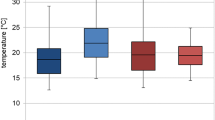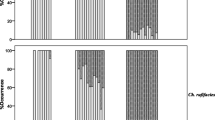Abstract
Over the last decades, studies on juvenile development of forensically important Diptera were performed by using non-human tissues (e.g., beef liver) as a nutrition medium. Such developmental data are used as a reference in determining the age of juvenile necrophagous insects sampled from a human body and thereby to estimate the minimum postmortem interval (PMImin). Despite the acceptance of these studies in the forensic community, some might ask whether such data appropriately reflect the growth of blow flies on human tissue. We, therefore, studied larval growth rates and development times of Calliphora vicina (Diptera: Calliphoridae) on human muscle tissue as well as on pork loin, pork liver, and minced pork at 25 °C. Larval growth rates were significantly (p < 0.001) slower on pork loin and pork liver compared to human muscle tissue. Nonetheless, the time at which the examined developmental landmarks “post-feeding larvae,” “pupae,” and “adult fly” were reached was similar for all tissues, with significant delays in first fly eclosion only for specimens reared on pork loin (p = 0.027) and pork liver (p = 0.036). Our results highlight the fact that not all porcine tissues are similarly suitable for producing sound growth data for necrophagous Diptera. At present, we recommend the use of minced pork as a non-human nutrition medium, since our results show no developmental differences on this diet compared to human tissue.


Similar content being viewed by others
References
Amendt J, Campobasso CP, Gaudry E et al (2007) Best practice in forensic entomology—standards and guidelines. Int J Legal Med 121:90–104
Amendt J, Richards CS, Campobasso CP et al (2011) Forensic entomology: applications and limitations. Forensic Sci Med Pathol 7:379–392
Ames C, Turner B (2003) Low temperature episodes in development of blowflies: implications for postmortem interval estimation. Med Vet Entomol 17:178–186
Byrd JH, Allen JC (2001) The development of the black blow fly, Phormia regina (Meigen). Forensic Sci Int 120:79–88
Byrd JH, Tomerberlin JK (2010) Laboratory rearing of forensic insects. In: Byrd JH, Castner JL (eds) (Hrsg) Forensic entomology: the utility of arthropods in legal investigations, 2nd edition. CRC Press, Boca Raton, pp S 177–201
Canavoso LE, Jouni ZE, Karnas KJ et al. (2001) Fat metabolism in insects I. Annu Rev Nutr. 23–46
Catts EP, Goff ML (1992) Forensic entomology in criminal investigations. Annu Rev Entomol 37:253–272
Charabidze D, Bourel B, Gosset D (2011) Larval-mass effect: characterisation of heat emission by necrophageous blowflies (Diptera: Calliphoridae) larval aggregates. Forensic Sci Int 211:61–66
Clark K, Evans L, Wall R (2006) Growth rates of the blowfly, Lucilia sericata, on different body tissues. Forensic Sci Int 156:145–149
Committee on Identifying the Needs of the Forensic Sciences Community NRC (2009) Strengthening forensic science in the United States: a path forward. Natl Acad Press
Day DM, Wallman JF (2006) Influence of substrate tissue type on larval growth in Calliphora augur and Lucilia cuprina (Diptera: Calliphoridae). J Forensic Sci 51:657–663
Donovan SE, Hall MJR, Turner BD, Moncrieff CB (2006) Larval growth rates of the blowfly, Calliphora vicina, over a range of temperatures. Med Vet Entomol 20:106–114
El-Moaty ZA, Kheirallah AEM (2013) Developmental variation of the blow fly Lucilia sericata (Meigen, 1826) (Diptera: Calliphoridae) by different substrate tissue types. J Asia Pac Entomol 16:297–300
Fischer MA, Nanz D, Shimakawa A et al (2013) Quantification of muscle fat in patients with low back pain: comparison of multi-echo MR imaging with single-voxel MR spectroscopy. Radiology 266:555–563
Forster J, Hirst AG, Woodward G (2011) Growth and development rates have different thermal responses. Am Nat 178:668–678
Goff ML, Omori AI, Goodbrod JR (1989) Effect of cocaine in tissues on the development rate of Boettcherisca peregrina (Diptera: Sarcophagidae). J Med Entomol 26:91–93
Grassberger M, Reiter C (2001) Effect of temperature on Lucilia sericata (Diptera: Calliphoridae) development with special reference to the isomegalen- and isomorphen-diagram. Forensic Sci Int 120:32–36
Greenberg B, Kunich JC (2002) Entomology and the law: flies as forensic indicators. Cambridge University Press
Harnden LM, Tomberlin JK (2016) Effects of temperature and diet on black soldier fly, Hermetia illucens (L.) (Diptera: Stratiomyidae), development. Forensic Sci Int 266:109–116
Hobson RP (1935) On a fat-soluble growth factor required by blow-fly larvae: identity of the growth factor with cholesterol. Biochem J 29:2023–2026
Introna F, Campobasso CP, Goff ML et al (2001) Entomotoxicology. Forensic Sci Int 120:42–47
Ireland S, Turner B (2006) The effects of larval crowding and food type on the size and development of the blowfly, Calliphora vomitoria. Forensic Sci Int 159:175–181
Kaneshrajah G, Turner B (2004) Calliphora vicina larvae grow at different rates on different body tissues. Int J Legal Med 118:242–244
Kumar D, Karampinos DC, MacLeod TD et al (2014) Quadriceps intramuscular fat fraction rather than muscle size is associated with knee osteoarthritis. Osteoarthr Cartil 22:226–234
Marcon M, Berger N, Manoliu A et al (2016) Normative values for volume and fat content of the hip abductor muscles and their dependence on side, age and gender in a healthy population. Skeletal Radiol 45:465–474
Niederegger S, Wartenberg N, Spiess R, Mall G (2013) Influence of food substrates on the development of the blowflies Calliphora vicina and Calliphora vomitoria (Diptera, Calliphoridae). Parasitol Res 112:2847–2853
Reiter C (1984) Zum Wachstumsverhalten der Maden der blauen Schmeißfliege Calliphora vicina. Rechtsmedizin 91:295–308
Saunders DS, Bee A (1995) Effects of larval crowding on size and fecundity of the blow fly, Calliphora vicina (Diptera: Calliphoridae). Eur J Entomol 92:615–622
Shiao S-F, Yeh T-C, Baumgartner DL et al (2008) Larval competition of Chrysomya megacephala and Chrysomya rufifacies (Diptera: Calliphoridae): behavior and ecological studies of two blow fly species of forensic significance. J Med Entomol 45:785–799
Tomberlin JK, Mohr R, Benbow ME et al (2011) A roadmap for bridging basic and applied research in forensic entomology. Annu Rev Entomol 56:401–421
Ullyett GC (1950) Competition for food and allied phenomena in sheep-blowfly populations. Philos Trans R Soc London Ser B, Biol Scienes 234:77–174
Uvarov BP (1929) Insect nutrition and metabolism. Trans R Entomol Soc London 76:255–343
Wells JD, Kurahashi H (1994) Chrysomya megacephala (F.) development: rate, variation and the implications for forensic entomology. 45:303–309
Acknowledgments
We thank Klaus Grduszak, Miriam Saulich, Lucy Taube, Stephanie Plenzig, and Peter Kömpel for their support in sampling human and porcine tissues and Kwankamol Limsopatham for helping to record the growth data.
Author information
Authors and Affiliations
Corresponding author
Ethics declarations
Conflict of interest
The authors declare that they have no conflict of interest.
Ethical approval
All procedures performed in studies involving human participants were in accordance with the ethical standards of the institutional and/or national research committee and with the 1964 Helsinki declaration and its later amendments or comparable ethical standards. All applicable international, national, and/or institutional guidelines for the care and use of animals were followed.
Rights and permissions
About this article
Cite this article
Bernhardt, V., Schomerus, C., Verhoff, M.A. et al. Of pigs and men—comparing the development of Calliphora vicina (Diptera: Calliphoridae) on human and porcine tissue. Int J Legal Med 131, 847–853 (2017). https://doi.org/10.1007/s00414-016-1487-0
Received:
Accepted:
Published:
Issue Date:
DOI: https://doi.org/10.1007/s00414-016-1487-0




